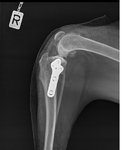
TPLO Surgery for CCL rupture in Dog
TPLO as treatment for a cranial cruciate ligament (CCL) rupture
When the cruciate ligament is torn, surgical stabilization is by far the best option. Surgery is generally recommended as quickly as possible to prevent permanent and irreversible damage to the joint and adequate pain relief. Several surgical techniques are currently used to correct a CCL rupture. Each procedure has unique advantages and potential drawbacks. At ABVC, we perform and advocate TPLO for all dogs above 20kg and we recommend the “over the top” vs “extra-capsular technique” for the small breeds.
What does TPLO stand for?
TPLO is an abbreviation for Tibial Plateau Levelling Osteotomy.

It involves changing the angle of the top of the shin bone (the tibial plateau) by making a circular cut on the tibia to rotate the tibial plateau. The tibial plateau is rotated until it reaches an approximate angle of 90 degrees relative to the quadriceps muscle (shown in left figure 1). This will allow the powerful quadriceps muscle of the thigh to act on the top of the tibia and stabilize the joint.
The cut on the tibia is then stabilized by placing a locking plate as seen in the post-operative figure 2 below.
 The TPLO surgery will completely alter the dynamics of the knee. Once the bone is cut and the tibial plateau rotated, the femur can no longer slide backwards. The knee is immediately stabilized. This eliminates the need for the CCL ligament entirely and returns stability to the joint.
The TPLO surgery will completely alter the dynamics of the knee. Once the bone is cut and the tibial plateau rotated, the femur can no longer slide backwards. The knee is immediately stabilized. This eliminates the need for the CCL ligament entirely and returns stability to the joint.
Which aftercare is necessary?
Aftercare following a TPLO surgery is important, and it may take a few weeks to months for your dog to fully recover. We will prescribe antibiotics and painkillers at the time of discharge. Your dog will wear an Elizabethan collar to prevent licking the wound. Exercise must be restricted for the first few weeks till the soft tissue and cut bone heal. Exercise will therefore be limited to small walks for toileting purposes. After a few weeks, exercise may be gradually increased in a controlled manner (lead). Depending on the progress advice will be given regarding increasing exercise during the recheck visits.
What is the prognosis for TPLO?
The long-term outcome following TPLO surgery is very satisfying, with as many as 90-95% of dogs returning to near-normal function. Early surgical treatment of CCL rupture using TPLO will help to decrease the likelihood of osteoarthritis progression and meniscal injuries. Complications associated with the TPLO procedure are numerous, like for any other surgery. However, they can be avoided if adequate rest, vet checks, and proper rehabilitation are conducted. Bone plates are not strong enough to resist normal activity, which is why the activity level must be reduced during the bone healing process.
Contact us if you have any additional questions regarding the CCL fracture and TPLO surgery.
Written and updated by:
Dr. Mehdi Mzabi, ABVC Partner and Veterinarian
Member of the French Conseil de l’ordre of Veterinary Doctors, Internship in Small Animal Surgery, and Member of the European Society of Veterinary Orthopaedics and Traumatology
